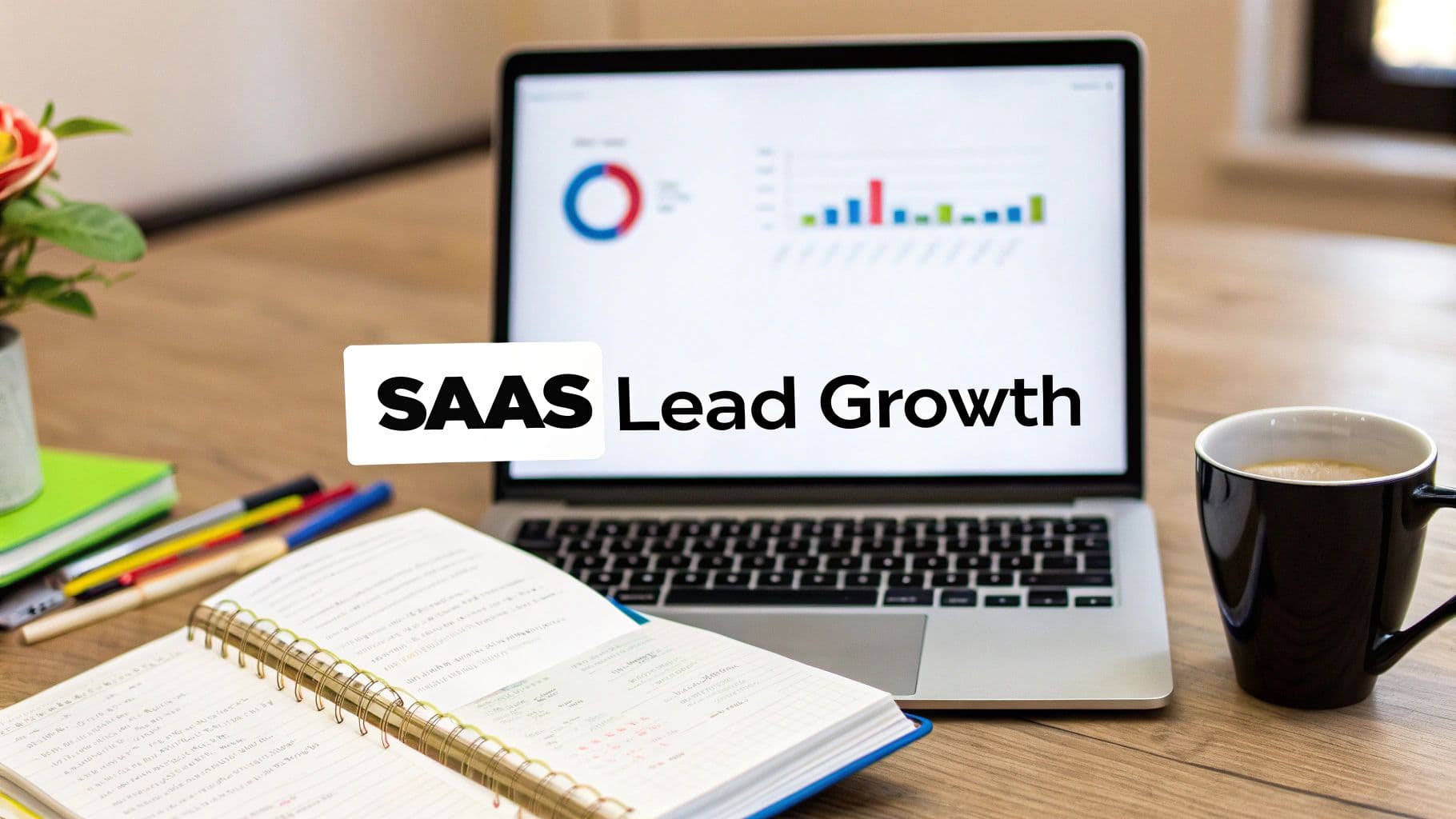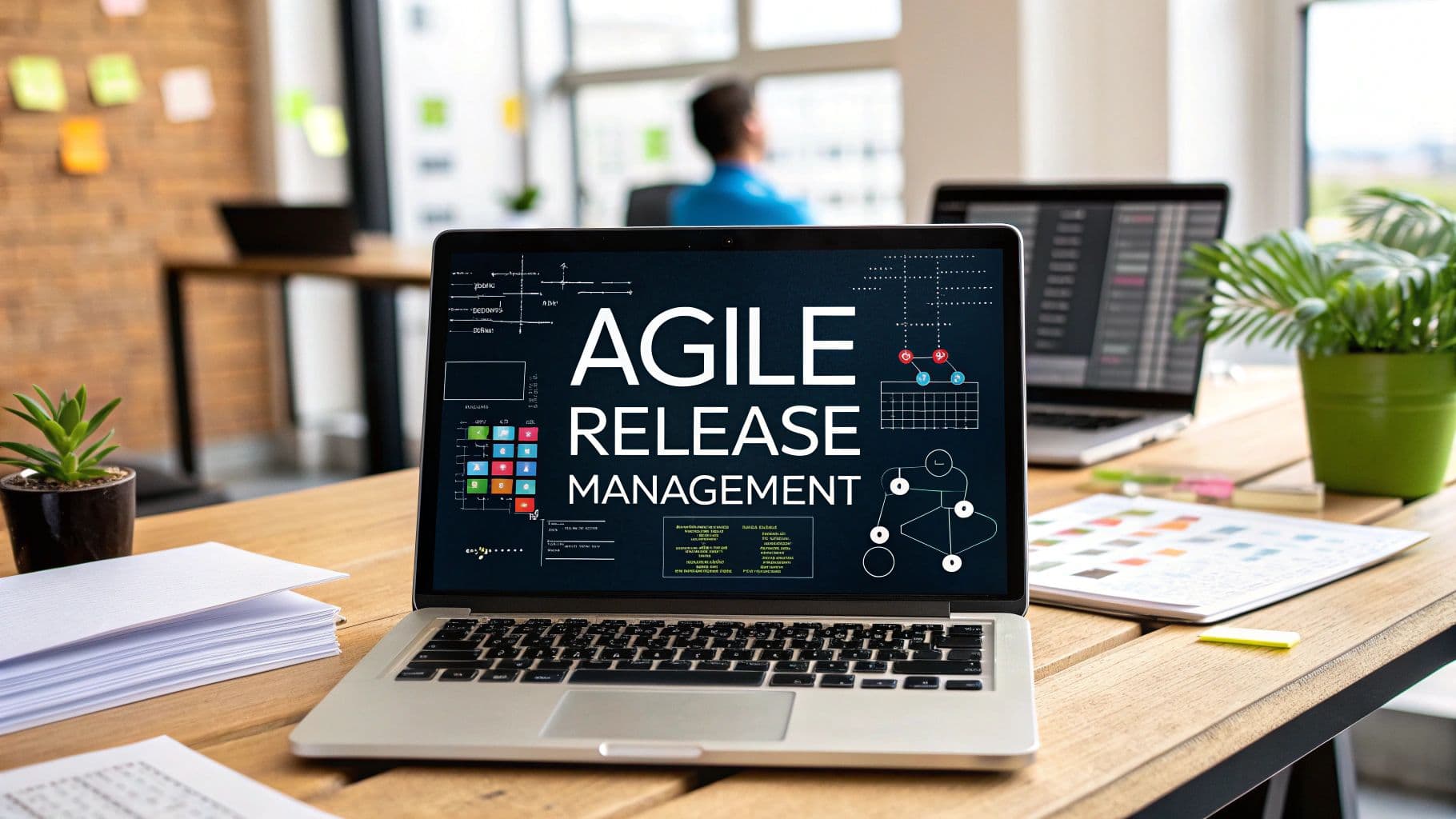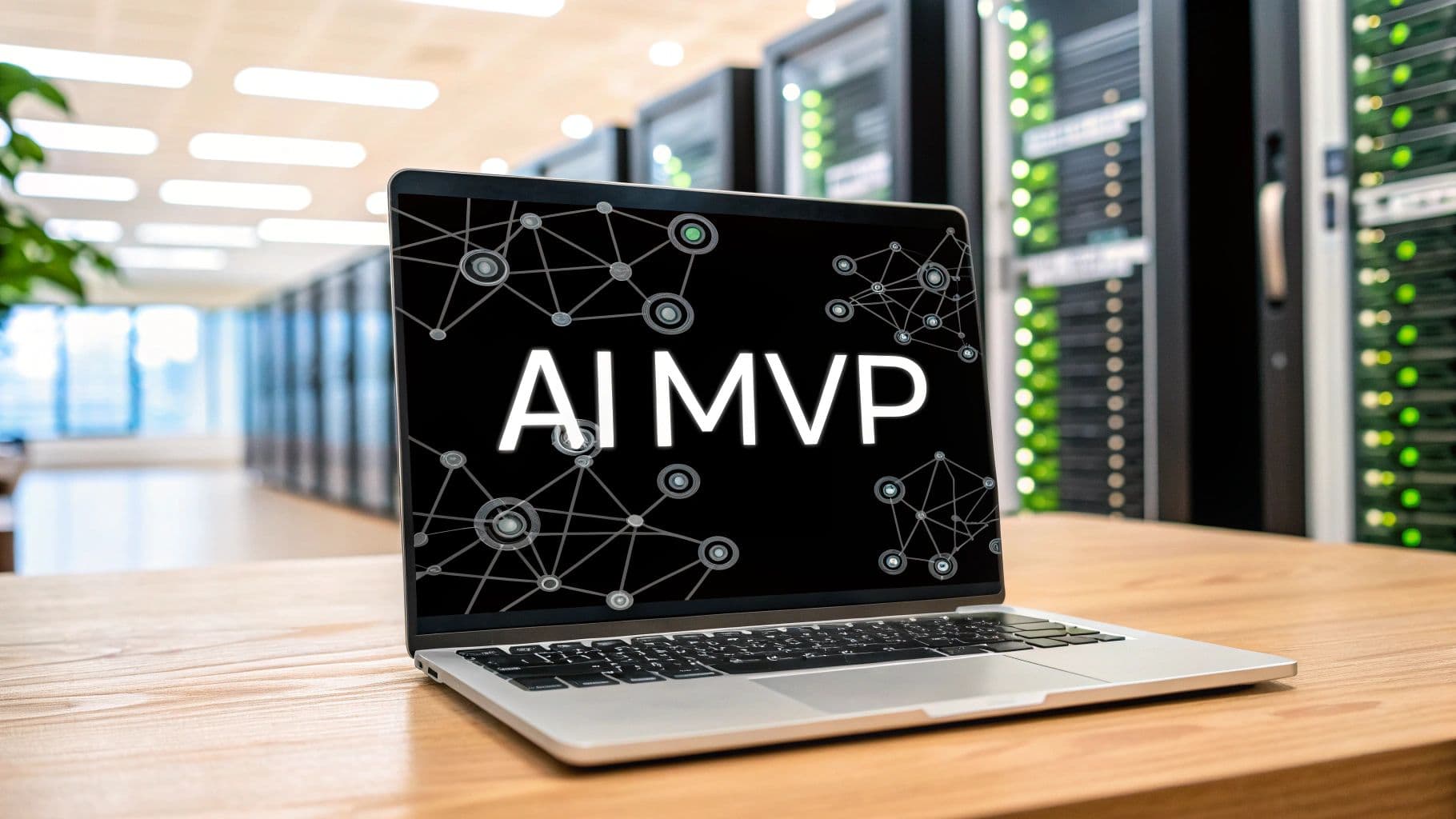saas lead generation
b2b marketing
saas growth
lead generation
marketing strategies
10 Proven SaaS Lead Generation Strategies for 2025
Beyond the Build: Your Blueprint for Sustainable SaaS Growth
In the competitive SaaS landscape, a brilliant product is only the first step. You've invested countless hours in development, but the real challenge often begins after the final line of code is shipped: acquiring a steady, predictable stream of qualified leads. This is not just about driving random traffic. It is about systematically attracting potential customers who will convert, remain loyal, and ultimately become advocates for your platform. The pressure to generate these leads can be overwhelming, pulling critical focus away from core product innovation and improvement.
This pressure is magnified for modern founders. With powerful development accelerators and low-code platforms streamlining the build process from months to mere days, the spotlight shifts almost immediately and intensely onto marketing and sales execution. Your go-to-market strategy becomes the primary determinant of success. This guide is your strategic blueprint for mastering SaaS lead generation.
We will move beyond the generic advice that floods the internet. Instead, we will dive deep into ten proven, actionable strategies that top SaaS companies use to build and sustain their growth engines. You will discover how to implement powerful frameworks, from user-centric Product-Led Growth (PLG) and targeted Account-Based Marketing (ABM) to scalable content strategies and high-converting referral programs. Each section provides the detailed insights, specific examples, and practical steps needed to construct a robust lead pipeline. This is your comprehensive plan to stop worrying about where your next customer will come from and start turning your innovative product into a recognized market leader.
1. Free Trial / Freemium Model
The product-led growth (PLG) approach, championed by models like the free trial or freemium plan, is a cornerstone of modern SaaS lead generation. Instead of just telling prospects about your product's value, this strategy lets them experience it directly. A free trial offers full or partial access for a limited time (e.g., 14 or 30 days), while a freemium model provides a perpetually free, feature-limited version of the product. This removes the initial purchase friction and allows your software to become its own best salesperson.
How This Model Drives Leads
This strategy works by transforming your product into a powerful lead magnet. Companies like Slack, with its freemium plan limited by message history and integrations, and HubSpot, with its free CRM, attract millions of users. These users, known as Product-Qualified Leads (PQLs), are highly valuable because they already understand the product's basic functionality and see its potential. The goal is to demonstrate undeniable value, making the upgrade to a paid plan a logical next step rather than a difficult sales decision.
The following bar chart visualizes key performance benchmarks for these product-led models.
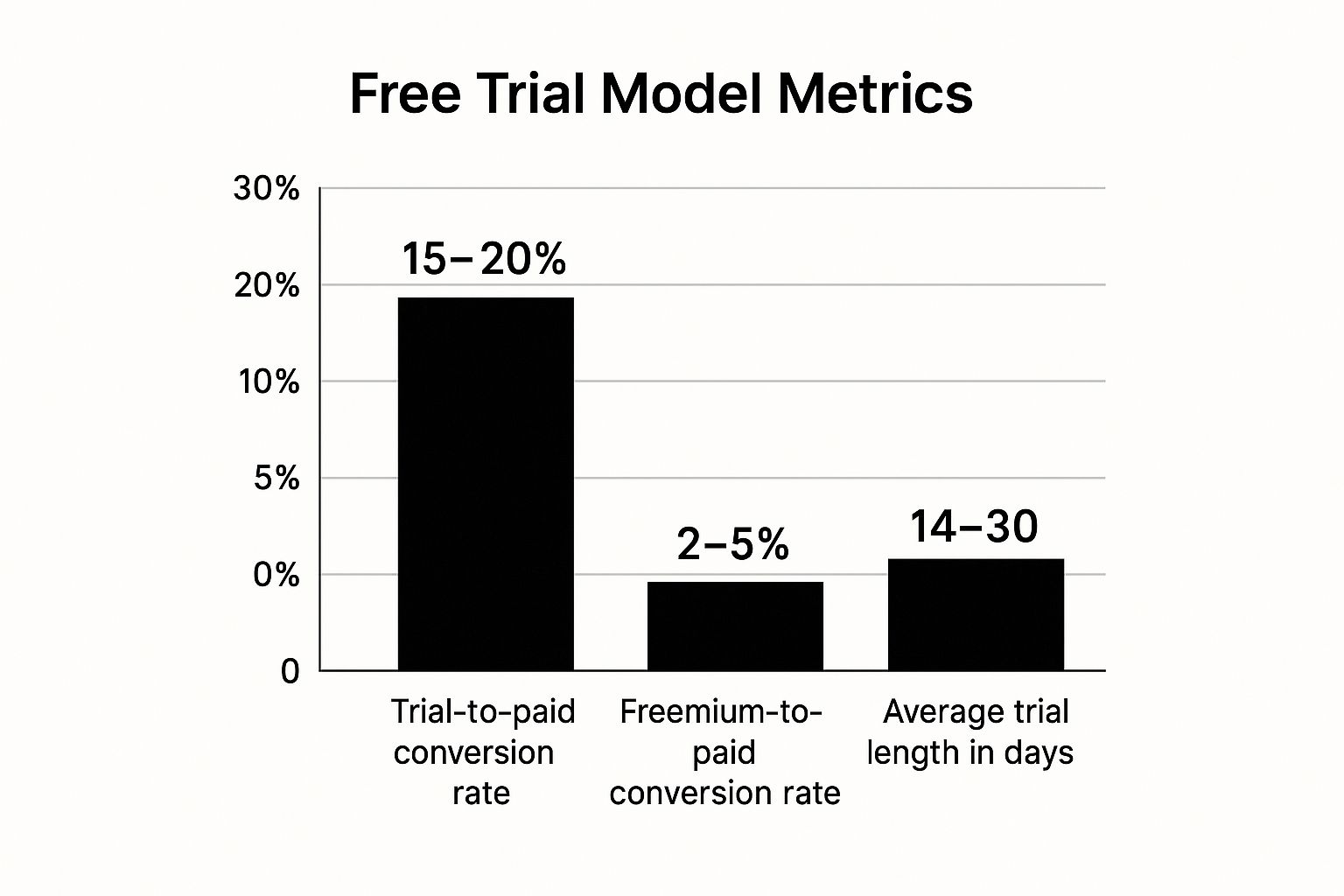 The data clearly shows that while freemium models cast a wider net, time-limited trials typically yield significantly higher conversion rates.
The data clearly shows that while freemium models cast a wider net, time-limited trials typically yield significantly higher conversion rates.
Best Practices for Implementation
To maximize conversions from your free offering, focus on a seamless user journey.
- Define Smart Limitations: The key is to provide enough value to be useful but hold back essential features that drive upgrades. For example, limit the number of users, projects, or storage, like Dropbox does with its free accounts.
- Invest in Onboarding: Your first priority is to guide new users to their "aha!" moment as quickly as possible. Use tutorials, checklists, and tooltips to showcase core value.
- Use In-App Nudges: Contextually prompt users to upgrade when they try to access a premium feature. This highlights the value of paid plans at the exact moment of need.
- Monitor Engagement: Track user behavior to identify who is most likely to convert. High-frequency users or those exploring premium feature pages are prime candidates for targeted outreach. For those just starting out, you can explore the foundational elements of building a better SaaS to incorporate these models from the ground up.
2. Content Marketing & SEO
Content marketing, powered by Search Engine Optimization (SEO), is a foundational long-term strategy for sustainable SaaS lead generation. This inbound approach focuses on creating and distributing valuable, relevant, and consistent content to attract and retain a clearly defined audience. Instead of pushing a sales message, you pull customers in by offering solutions to their problems, establishing your brand as a trusted authority in your niche.
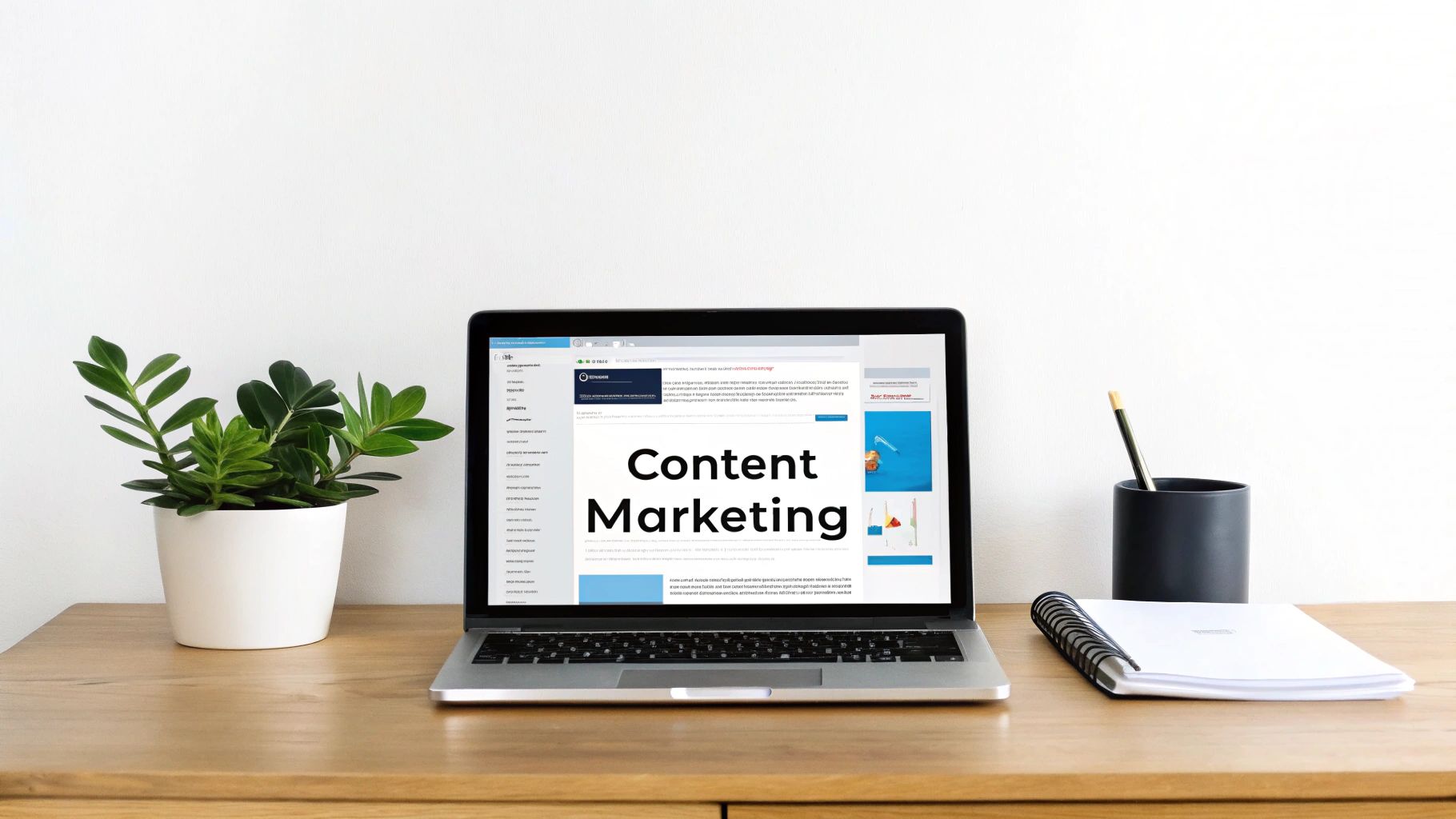
How This Model Drives Leads
This strategy turns your company blog and resource center into a lead generation machine. When a potential customer searches for a solution to a problem your SaaS solves, your content appears at the top of the search results. Companies like Ahrefs, with its world-class SEO blog, and HubSpot, whose marketing resources are industry-defining, have mastered this. They attract millions of organic visitors by answering user questions, building trust, and then strategically converting that traffic into leads through calls-to-action (CTAs), content upgrades, and newsletter sign-ups. These are high-quality leads because they arrive with a specific problem and discover you as the expert solution.
Best Practices for Implementation
A successful content strategy requires more than just writing blog posts; it demands a strategic approach to creation, distribution, and conversion.
- Target High-Intent Keywords: Focus on bottom-of-the-funnel (BoFu) keywords that signal purchase intent (e.g., "best project management software for agencies") alongside top-of-funnel (ToFu) keywords to build awareness.
- Create Topic Clusters: Build your authority by creating a central "pillar" page for a broad topic and linking out to more detailed "cluster" posts on related sub-topics. This structure is favored by search engines and improves user experience.
- Use Gated Content Upgrades: Offer valuable, downloadable resources like ebooks, checklists, or templates in exchange for an email address. This is a classic method to convert passive readers into active leads.
- Repurpose Content: Maximize your efforts by turning a single piece of content into multiple formats. A blog post can become a webinar, an infographic, a video tutorial, or a series of social media posts.
- Track Lead Attribution: Use analytics to track which pieces of content are generating the most traffic, engagement, and, most importantly, qualified leads. This data is critical for refining your strategy over time.
3. Product-Led Growth (PLG)
Product-Led Growth (PLG) is a go-to-market strategy that places the product itself at the center of the customer journey. Instead of relying on sales demos or marketing pitches, PLG uses the product experience as the primary driver for customer acquisition, conversion, and expansion. This approach is fundamental to modern SaaS lead generation, as it allows the product’s inherent value to attract and qualify users organically.
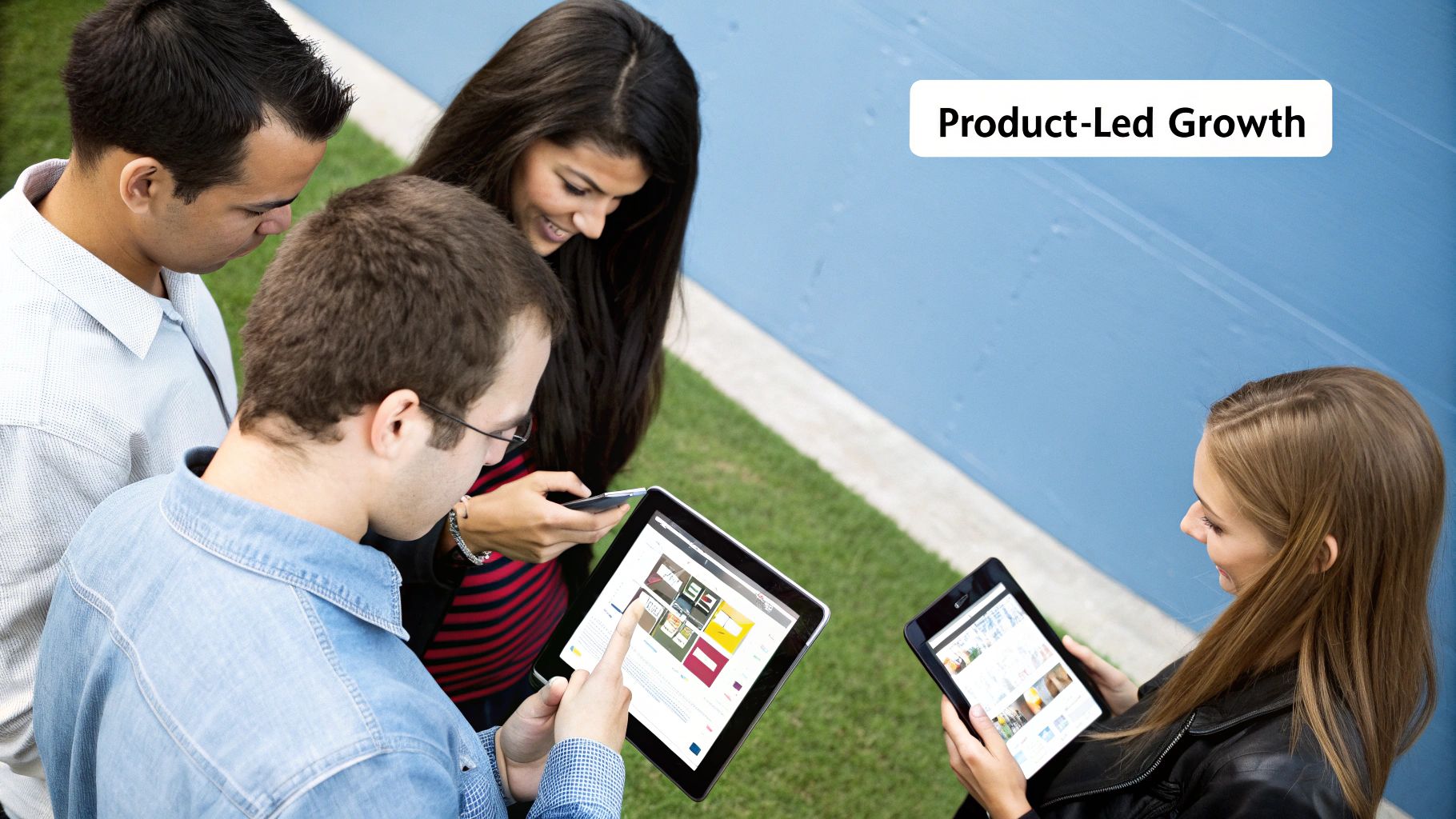
How This Model Drives Leads
PLG generates leads by creating a natural viral loop where the product is designed to be inherently shareable, turning active users into advocates. For instance, when a Calendly user shares their booking link, every recipient is introduced to the product in a frictionless, contextual way. Similarly, a Slack user inviting a colleague to a channel is simultaneously using the product and generating a new lead. This user-driven acquisition model, seen in tools like Loom and Notion, creates a powerful, scalable engine where product usage directly fuels growth without significant traditional sales intervention.
Best Practices for Implementation
Successfully implementing a PLG strategy requires careful design and an obsessive focus on the user experience from the very first interaction.
- Embed Virality: Design sharing and collaboration directly into the core workflow. Make it easy and logical for users to invite others, share content, or work together, like Figma's real-time collaboration features.
- Minimize Time-to-Value: Your number one goal should be to get new users to their "aha!" moment as fast as possible. A seamless and intuitive onboarding process is critical for demonstrating value and encouraging retention.
- Implement Usage-Based Triggers: Use in-product cues to prompt upgrades. When a user hits a usage limit or tries to access a premium feature, present a relevant paid plan at their moment of highest intent.
- Focus on Stickiness: Build features that integrate your product into a user's daily routine, making it indispensable. The higher the daily active usage, the more opportunities you create for expansion and advocacy.
4. Account-Based Marketing (ABM)
Account-Based Marketing (ABM) flips the traditional lead generation funnel on its head. Instead of casting a wide net to capture as many individual leads as possible, ABM is a highly focused strategy where marketing and sales teams collaborate to target a select list of best-fit, high-value accounts. This approach treats each target company as a "market of one," delivering personalized experiences designed to resonate with key decision-makers and drive significant revenue. For B2B companies with high-value contracts, ABM is an incredibly effective form of SaaS lead generation.
How This Model Drives Leads
ABM drives leads by concentrating resources on accounts that have the highest potential for partnership and lifetime value. Instead of waiting for inbound leads, you proactively identify and engage your ideal customers. Companies like Salesforce excel at this by tailoring enterprise-level solutions and outreach for Fortune 500 companies. Platforms such as 6sense and Demandbase use AI to identify accounts showing purchase intent, allowing teams to create hyper-personalized website experiences and ad campaigns. This targeted, multi-channel approach ensures you're engaging the entire buying committee, not just one contact, leading to more robust opportunities and a shorter sales cycle.
Best Practices for Implementation
Successful ABM execution requires tight alignment and a data-driven mindset. To get started, focus on these core principles:
- Start with a Pilot Group: Select a small, manageable list of 5-10 high-value accounts to test and refine your strategy before scaling your efforts.
- Invest in Account Research: Go beyond basic firmographics. Deeply understand each target account's specific pain points, strategic initiatives, and key players to create truly resonant messaging.
- Align Sales and Marketing: This is the cornerstone of ABM. Both teams must be perfectly synchronized on target account selection, campaign goals, messaging, and success metrics.
- Use Intent Data: Leverage third-party intent data to identify when target accounts are actively researching solutions. This allows you to time your outreach for maximum impact.
- Measure Account Engagement: Shift your focus from individual MQLs to account-level metrics like pipeline velocity, deal size, and meetings booked across the organization. To help manage these complex interactions, you can explore specialized ABM and account management tools that centralize data and streamline workflows.
5. Webinars and Virtual Events
Webinars and virtual events are a powerful strategy for engaging prospects at scale by offering direct educational value. Instead of a hard product pitch, this approach positions your company as a thought leader in your niche. By hosting live or on-demand sessions on topics your target audience cares about, you can demonstrate expertise, build trust, and address key pain points, making your product the natural solution. This method is a cornerstone of modern SaaS lead generation because it attracts an engaged audience actively seeking knowledge.
How This Model Drives Leads
This strategy turns educational content into a high-quality lead capture mechanism. To attend, prospects must register with their contact details, instantly converting them into leads for your marketing and sales funnels. Companies like HubSpot excel with their Inbound marketing educational series, while Monday.com runs productivity workshops that attract ideal users. These leads are highly qualified because they have self-selected by showing interest in a topic directly related to your software's value proposition. The live, interactive format also allows for real-time Q&A, enabling you to handle objections and build rapport directly with potential customers.
The following video breaks down how to create a webinar that effectively converts attendees into customers.
Best Practices for Implementation
To transform your virtual events into a reliable lead engine, focus on delivering an exceptional and valuable experience.
- Prioritize Education Over Promotion: Structure your webinar around solving a genuine problem for your audience. A good rule of thumb is the 90/10 rule: 90% pure educational content and only 10% dedicated to how your product fits into the solution.
- Maximize Engagement: Use compelling, benefit-driven titles to drive registrations. During the event, keep the audience engaged with interactive elements like live polls, Q&A sessions, and chat discussions to prevent drop-offs.
- Implement a Strategic Follow-Up: Don't let the relationship end when the webinar does. Create automated email sequences tailored to different segments, sending the recording and relevant resources to attendees and a "sorry we missed you" offer to no-shows.
- Repurpose Your Content: Extend the life of your webinar by repurposing the content. Edit the recording into short video clips for social media, transcribe the audio into a blog post, and use key insights to create an infographic or a lead-nurturing email series.
6. Referral Programs
Referral programs formalize word-of-mouth marketing, transforming your loyal customers into a powerful extension of your sales team. This is a highly effective SaaS lead generation strategy that incentivizes existing users to recommend your product to their network. By offering a reward for successful referrals, you systematically leverage the trust and social proof inherent in peer-to-peer recommendations, creating a sustainable growth engine that operates with minimal direct sales involvement.
How This Model Drives Leads
This strategy's power lies in trust. A lead who comes from a friend or colleague's recommendation is inherently warmer and more qualified than one from a cold ad. Companies like Dropbox famously used this to achieve explosive growth, offering free storage to both the referrer and the new user. This two-sided incentive created a viral loop. Similarly, Airbnb’s travel credits and PayPal’s cash bonuses demonstrate that the reward can be tailored to your product and audience, driving high-intent leads who are predisposed to trust your brand and convert at a higher rate.
Best Practices for Implementation
To build a referral program that generates consistent results, focus on removing friction and providing clear value.
- Make Sharing Effortless: Provide customers with a unique, easy-to-copy referral link. Integrate one-click sharing options for email and social media directly into your app's dashboard. The fewer steps required, the higher your participation rate will be.
- Offer Valuable, Two-Sided Rewards: Motivate action by rewarding both the referrer and the new customer. This could be product credits, a subscription discount, or access to premium features. A win-win structure makes the referrer feel like they are giving a gift, not just selling.
- Promote the Program Continuously: Don’t let your program be a secret. Announce it in email newsletters, highlight it with in-app notifications, and create a permanent, visible link in the user's account area to ensure it stays top-of-mind.
- Track and Optimize Performance: Monitor key metrics like share rate, click-through rate, and referral conversion rate. Identify your most successful advocates and analyze what makes them effective to refine your approach.
- Celebrate and Recognize Top Referrers: Create a simple leaderboard or send a personal thank you to your top advocates. Public recognition or small, exclusive perks can foster loyalty and encourage continued promotion.
7. LinkedIn Outreach and Social Selling
In the B2B world, LinkedIn is more than just a digital resume; it's a dynamic engine for SaaS lead generation. Social selling moves beyond spammy connection requests and cold InMail messages. It’s a targeted strategy focused on identifying ideal customer profiles, building genuine relationships through value-driven engagement, and positioning your brand as a trusted authority. This human-centric approach, popularized by experts like Jill Konrath, turns a professional network into a predictable source of high-quality leads.
How This Strategy Drives Leads
This strategy works by transforming your sales team from cold callers into industry advisors. For example, enterprise sales teams use LinkedIn Sales Navigator to pinpoint decision-makers at target accounts based on highly specific criteria like company size, industry, and recent job changes. Simultaneously, thought leadership content from a CEO or key executive, such as insightful articles or commentary on industry trends, can attract inbound interest from prospects seeking expertise. The goal is to warm up potential leads by providing value long before you ever ask for a meeting, making the eventual sales conversation a natural next step.
Best Practices for Implementation
To turn LinkedIn activity into a consistent lead pipeline, focus on authentic, value-first interactions.
- Personalize Every Request: Ditch the generic template. Reference a mutual connection, a recent post they shared, or a piece of company news to show you’ve done your homework.
- Engage Before Connecting: Like, comment on, and share a prospect's content for a week or two before sending a connection request. This builds familiarity and shows genuine interest in their work.
- Master Sales Navigator: Use its advanced filters to create hyper-targeted lead lists. Save searches and set up alerts to stay informed about key activities within your target accounts.
- Share Value, Not Just Pitches: Consistently post content that educates and helps your audience, establishing your credibility. This positions you as the go-to expert when they eventually need a solution like yours.
- Leverage New Relationships: Once you've built trust, these connections are prime candidates for advocacy. Learning how to create a referral program can help you formalize this process and turn satisfied leads into a powerful, ongoing source of new business.
8. Partnership and Integration Marketing
Tapping into another company's audience through partnerships is one of the most scalable SaaS lead generation strategies. This approach involves collaborating with complementary, non-competing businesses to cross-promote products and access new customer bases. By creating a technical integration or a co-marketing campaign, you leverage the trust and authority your partner has already built with their audience, resulting in high-quality, warm leads that are more likely to convert.
How This Model Drives Leads
Partnership marketing transforms another company's ecosystem into your lead-generation channel. Consider Salesforce's AppExchange or the Shopify App Store; these marketplaces are built on the idea that combined solutions offer more value. When a user is already invested in a platform like Shopify, they actively seek out integrations to extend its functionality. Your app becomes the solution they need, recommended within a trusted environment. This symbiotic relationship, famously championed by companies like Zapier, generates leads by solving an existing user's problem at the exact moment of need.
Best Practices for Implementation
To build a successful partnership engine, focus on mutual value and a seamless user experience.
- Choose Strategic Partners: Identify companies whose products complement yours. A project management tool could partner with a time-tracking app, for instance. Ensure their audience demographics and business values align with yours.
- Define a Joint Value Proposition: Don't just list features. Clearly articulate why your combined solution is better for the customer. How does the integration solve a bigger problem or create a more efficient workflow?
- Invest in a Quality Integration: A buggy or confusing integration will harm both brands. Prioritize a seamless user experience from authentication to daily use. The integration itself should be a key selling point.
- Systematize Partner Outreach: Develop a clear process for identifying and contacting potential partners. For high-volume outreach on professional networks, you can explore effective LinkedIn automation strategies for lead generation to connect with key decision-makers efficiently.
- Establish Clear Agreements: Formalize the partnership with clear terms on revenue sharing, marketing commitments, and support responsibilities. Track key performance indicators to measure ROI and ensure the partnership remains mutually beneficial.
9. Email Marketing and Lead Nurturing
Once you capture a lead, the journey has just begun. Email marketing and lead nurturing are critical for building relationships and guiding prospects from initial interest to a final purchase decision. This strategy moves beyond generic email blasts, focusing instead on delivering targeted, valuable content based on a lead's behavior, interests, and stage in the sales funnel. It’s the engine that powers sustained engagement for any successful SaaS lead generation strategy, keeping your brand top-of-mind throughout a potentially long buying cycle.
How This Model Drives Leads
Lead nurturing works by maintaining a thoughtful connection with prospects who aren't ready to buy yet. By systematically providing helpful content, you build trust and educate leads on how your solution solves their specific problems. For instance, a new signup might receive a welcome series from Mailchimp that onboards them to the platform and showcases key features. Later, an automated workflow from a platform like ActiveCampaign can trigger an email when a user approaches a usage limit, highlighting the benefits of upgrading. Intercom excels at this with behavior-triggered messages, such as reaching out to a user who hasn't logged in for a week, effectively re-engaging them before they churn and turning a cold lead into a warm, educated prospect.
Best Practices for Implementation
To build an effective nurturing machine, your approach must be strategic and user-centric.
- Segment Your Lists: Group contacts based on behavior (e.g., webinar attendees vs. trial users), firmographics, or the lead magnet they downloaded. This allows for highly personalized and relevant messaging.
- Provide Genuine Value: Your emails shouldn't just be sales pitches. Share case studies, helpful tips, industry reports, or exclusive content that helps your prospect do their job better, establishing your brand as a trusted authority.
- Write Compelling Copy: Craft subject lines and preview text that spark curiosity and promise value. Personalization, like using the prospect's name or referencing their company, significantly boosts open rates.
- Test and Optimize: Don't guess what works. A/B test everything, including send times, frequency, calls-to-action, and content formats, to discover what resonates most with your audience segments.
- Automate and Maintain: Use automation to scale your nurturing sequences while maintaining list hygiene to ensure high deliverability. For those looking to streamline these complex workflows, you can explore powerful marketing automation platforms to manage your campaigns efficiently.
10. Search Engine Marketing (SEM) and PPC
While content and SEO build long-term authority, Search Engine Marketing (SEM) and Pay-Per-Click (PPC) advertising offer an immediate and highly controllable path to SaaS lead generation. This strategy involves paying for ad placements on platforms like Google, Bing, LinkedIn, or Facebook to capture demand at the precise moment a prospect is searching for a solution. It allows you to bypass the long wait for organic rankings and place your software directly in front of an engaged audience ready to act.
How This Model Drives Leads
SEM works by targeting users based on specific keywords, demographics, interests, and behaviors. When a potential customer searches Google for "cloud-based accounting software," your ad can appear at the top of the results, driving them to a dedicated landing page designed for conversion. Similarly, platforms like LinkedIn Ads allow you to target professionals by job title, industry, and company size, making it a powerhouse for B2B SaaS solutions. This direct-response approach generates highly qualified traffic quickly, as you are reaching people who have already expressed commercial intent.
Best Practices for Implementation
To get the best return on your ad spend, a strategic approach is non-negotiable. A well-executed PPC campaign can become a predictable and scalable engine for growth.
- Focus on High-Intent Keywords: Target bottom-funnel keywords like "[your software category] for enterprise" or "[competitor] alternative" to capture users who are close to making a purchase decision.
- Create Dedicated Landing Pages: Don't send ad traffic to your homepage. Each campaign needs a unique landing page that mirrors the ad's messaging and has a single, clear call-to-action.
- Use Negative Keywords: Actively build a list of negative keywords to prevent your ads from showing for irrelevant searches. This simple step sharpens your targeting and saves a significant amount of your budget.
- Implement Robust Conversion Tracking: Meticulously track lead form submissions, trial sign-ups, and demo requests to accurately measure campaign ROI and optimize for performance, not just clicks. Once you capture a lead, nurture them effectively. To improve your SaaS lead generation via email, consider implementing proven cold email automation strategies to guide them through the funnel.
SaaS Lead Generation Strategies Comparison
| Strategy | Implementation Complexity 🔄 | Resource Requirements ⚡ | Expected Outcomes 📊 | Ideal Use Cases 💡 | Key Advantages ⭐ |
|---|---|---|---|---|---|
| Free Trial / Freemium Model | Medium to High – requires product gating and onboarding flows | High – infrastructure, analytics, support | Moderate conversion rates, engaged trial users | SaaS products that benefit from direct user experience | Removes barriers, self-selling product, high engagement |
| Content Marketing & SEO | High – continuous content creation & SEO optimization | Medium to High – writing, SEO tools, distribution | Long-term organic traffic growth, brand authority | Companies building long-term inbound lead pipelines | Cost-effective, builds trust, evergreen value |
| Product-Led Growth (PLG) | High – strong product focus, UX/UI, analytics required | High – product development and data analytics | Faster sales cycles, viral user growth | SaaS with easy adoption and viral potential | Low CAC, scalable growth, data-driven insights |
| Account-Based Marketing (ABM) | High – personalized, multi-channel campaigns | High – research, tools, sales & marketing alignment | High ROI on targeted accounts, shorter sales cycles | B2B enterprise SaaS targeting specific key accounts | Highly efficient resource use, personalized experience |
| Webinars and Virtual Events | Medium – planning, technical setup, content preparation | Medium – event platform, content creation | High-quality engaged leads, thought leadership | Educational product demos, thought leadership building | Real-time interaction, reusable content |
| Referral Programs | Medium – program setup, tracking, rewards management | Medium – rewards costs, program management | High lead quality and conversion rates | SaaS with satisfied, loyal customers | Viral growth potential, cost-effective acquisition |
| LinkedIn Outreach & Social Selling | Medium to High – personalized outreach and engagement | Medium – time-intensive manual effort | Targeted B2B leads with strong relationship building | B2B SaaS targeting decision makers | Direct access to prospects, higher response rates |
| Partnership & Integration Marketing | High – coordination, joint campaigns, technical integrations | Medium to High – partner management, integration | New customer access, improved product value | SaaS looking to expand via ecosystem and integrations | Credibility boost, cost-sharing, faster market entry |
| Email Marketing & Lead Nurturing | Medium – campaign design, segmentation, automation setup | Medium – content creation, marketing automation | Sustained engagement, high ROI | Nurturing leads through funnels | Personalized scale communication, detailed analytics |
| Search Engine Marketing (SEM) & PPC | Medium to High – campaign setup, ongoing optimization | High – ad spend, management, creative production | Immediate traffic and leads | SaaS needing quick scale and precise targeting | Fast results, scalable budgets, detailed metrics |
Putting Your SaaS Lead Generation Plan into Action
You have now explored a comprehensive arsenal of 10 powerful strategies, each a proven engine for growth in the competitive SaaS landscape. From the magnetic pull of a Freemium model to the targeted precision of Account-Based Marketing, this list provides the essential building blocks. However, the most crucial takeaway is that these tactics rarely achieve their full potential in isolation. True mastery of SaaS lead generation comes not from executing a single strategy perfectly, but from building a diversified, interconnected system where each component amplifies the others.
The journey from a promising product to a market leader is paved with qualified leads. Gaining the skills to generate them consistently is not just a marketing function; it is a fundamental business imperative that directly fuels revenue, attracts investment, and builds a sustainable competitive advantage.
The Power of an Integrated Strategy
Think of these strategies not as a checklist, but as a web of interconnected gears. When one gear turns, it propels others, creating a powerful and self-sustaining growth machine. This synergy is where market leaders are made.
Consider these dynamic combinations:
- Content & Nurturing: A robust Content Marketing (Item 2) and SEO program doesn't just attract traffic. It generates valuable assets like whitepapers and case studies that become the lifeblood of your Email Marketing and Lead Nurturing (Item 9) sequences, guiding prospects from initial awareness to trial sign-up.
- Product-Led & Social Proof: A well-designed Product-Led Growth (Item 3) model creates a base of active, engaged users. These happy users are the perfect candidates for your Referral Program (Item 6), turning product adoption into a powerful, word-of-mouth acquisition channel.
- Events & High-Touch Sales: Hosting Webinars and Virtual Events (Item 5) allows you to capture a high-intent audience at scale. You can then segment the attendee list, identifying decision-makers from high-value companies for a more focused Account-Based Marketing (Item 4) or direct LinkedIn Outreach (Item 7) campaign.
This integrated approach creates a flywheel effect. Each new lead and customer feeds a system that becomes smarter, more efficient, and more effective over time.
Your Actionable Next Steps: From Theory to Reality
Feeling overwhelmed by the options is a common reaction. The key is to avoid analysis paralysis and take deliberate, measured action. Do not try to implement all ten strategies at once. Instead, follow a structured, phased approach.
1. Prioritize Based on Your Foundation: Start by auditing your unique situation.
- Your Product: Is it a low-cost, self-serve tool? Prioritize PLG, Freemium Models, and Content Marketing. Is it a high-ticket, complex enterprise solution? Focus on ABM, Webinars, and LinkedIn Social Selling.
- Your Audience: Where do your ideal customers spend their time? If they are actively searching for solutions, SEM/PPC and SEO are critical. If they are concentrated in specific industries, Partnership Marketing and targeted outreach may yield better results.
- Your Resources: Be realistic about your budget and team's skillset. Content Marketing is a long-term investment, while SEM can deliver faster results but requires a consistent budget.
2. Select Your "Core & Explore" Mix: Based on your audit, choose two "core" strategies to master. These will be the primary drivers of your SaaS lead generation efforts for the next 6-12 months. Concurrently, select one "explore" strategy to test with a smaller budget and timeline. This allows you to build a stable foundation while still experimenting with new channels.
3. Measure, Iterate, and Scale: You cannot improve what you do not measure. Establish a simple dashboard to track essential metrics for every channel you use: Cost Per Lead (CPL), Lead-to-Trial Conversion Rate, and ultimately, Customer Acquisition Cost (CAC). Review this data weekly, make informed adjustments, and be prepared to double down on what works and cut what doesn't.
The path to sustainable growth is a marathon, not a sprint. This blueprint is your guide to building a formidable lead generation engine that scales in lockstep with your ambition, transforming your SaaS from an idea into an institution.
To accelerate your journey, you need to focus your limited time on what matters most: marketing and talking to users. Instead of losing weeks building boilerplate features like user authentication, billing, and team management, you can get a production-ready foundation in minutes. Check out AnotherWrapper to launch your SaaS faster and dedicate your energy to executing the growth strategies you've learned today.
Fekri

